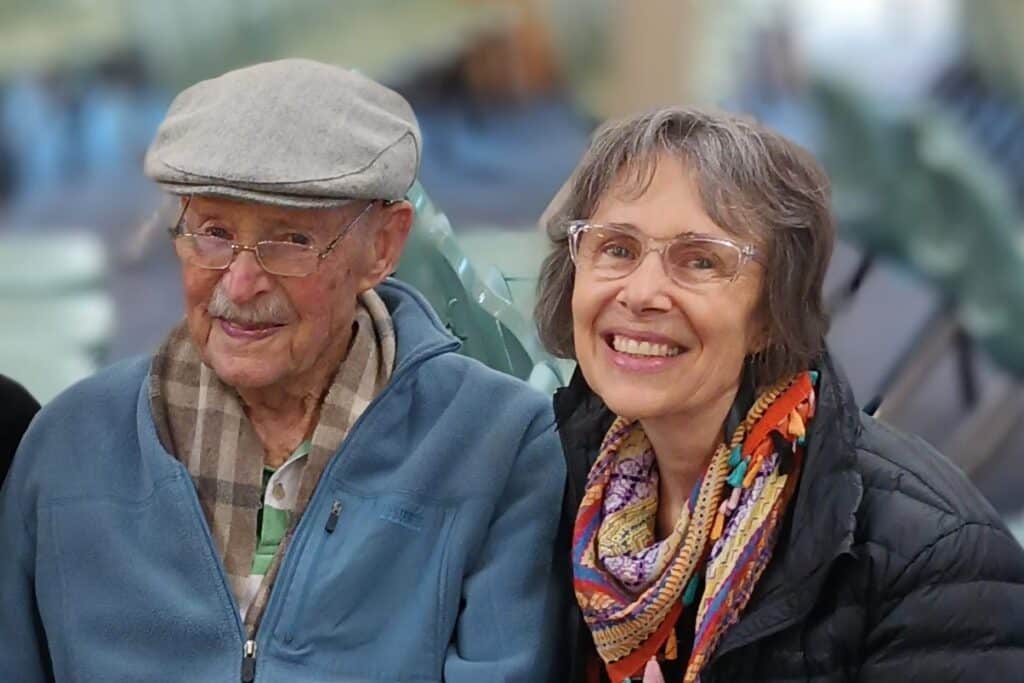
Mark Mullins
15 January 2024
The Reverend Joe Mullins MC – 16 July 1920 to 2 December 2023.
Gazing at the two gaping holes in his helmet where Japanese bullets had penetrated the steel and the dent where a bullet had bounced off, it was as if Major Joe Mullins heard the voice of God saying to him, “Joe, you’ve no right to be alive. Your only right to live, is to give yourself back to me”.
The date was 28 July 1945 and Mullins was commanding B Company of the First Battalion, The Queen’s Royal Regiment (West Surrey) in Burma. The Battalion was part of 33 Corps of Lieutenant General Sir William Slim’s 14th Army. Rangoon (now Yangon) had been captured on 6th May 1945 cutting off the Japanese 28th Army which then tried to escape to Thailand over the Sittang River. The Queen’s had orders to cut off the retreating Japanese forces despite being at half company strength (down to 60 from 120) mainly due to malaria and dysentery.
The Battalion had occupied a village called Letpanthonbyin. Leaving a skeleton force behind in the village, A and B companies (all that was left of the Battalion) were ordered to carry out a night fighting patrol to cut the Pegu-Martaban railway line along which it was believed the retreating Japanese were marching. Balancing on slippery paddy bunds (about 10cm above the flooded paddy fields) in the dark was no joke. They did not find the enemy that night and returned weary the next morning, 27 July, to discover that a Japanese force was now occupying the village. They received orders to retake the village from Brigade Headquarters. The enemy numbered at least 50 and had dug in, in the north half of the village.
The Commanding Officer, Lieutenant Colonel John Terry, ordered A Company on the right and Mullins’ B Company on the left to advance and drive out the enemy who were dug in behind a mud bank reservoir. The attack was delayed until the afternoon to allow the troops to rest and also because of friendly artillery fire which had caused casualties in A company. Mullins was ordered to put in the final attack with covering fire from A Company. The citation for Mullins’ Immediate Military Cross stated that the companies: “Went in with bullet and bayonet. They suffered casualties all the way and were under continual Jap fire but Major Mullins with complete disregard for personal safety and showing magnificent endurance and bravery kept his men going. They had cleared three quarters of the Jap positions when they came to the final pocket of resistance round a water tank with a heavy machine gun and a light machine gun.”
Mullins took up the story of what happened next. “Tiny Taylor, my Second-in-Command, was wounded and also my runner. Crouching behind the large mango tree (from which Mullins had been directing the attack), I called up Sergeant Everett and two other seasoned men and shared with them my plan, to crawl across A Company’s front, round the Buddhist Temple, to reach the bank of the reservoir on the East side…. So, as dusk fell with what ammunition and grenades we could muster we set off.”
By the time they reached the temple, darkness had fallen. Using grenades and bursts of Sten gun fire they leapfrogged from tree to tree arriving under the bank of the reservoir. Mullins’ citation continued: “It was dark by now and only the muzzle flashes showed the Jap positions. Major Mullins and four of his men, although with only a few rounds left, crawled right close in under the Jap fire, got on a corner of the tank and shot them off. During this crawl Major Mullins was shot twice through his steel hat… But for Major Mullins’ extreme bravery and powers of leadership the final pocket would not have been cleared and the whole Battalion would have had to start again in the morning. His very gallant determination decided the day.”
Mullins’ actions resulted in his group being cut off from the rest of the Battalion which had been ordered to withdraw when night fell. They spent the night with the remainder of the fanatical Japanese fighters just yards away from them. However, between 2 and 3am they heard a great commotion at the northern end of the reservoir as the remaining Japanese forces prepared to move. For Mullins and his small party their intentions were unclear. If it was down the bund towards them, that would have been the end but to their great relief and in answer to their prayers the Japanese retreated across the paddy fields to the east, helped in their flight by a few volleys from Mullins’ party.
Mullins then waited until first light before advancing on the deserted Japanese positions. They found them empty except for the British prisoners that the Japanese had left behind, who they released. They then marched down the village street singing songs like “Pack up your troubles in your old kit bag and smile…” so they would not be confused with the enemy. It was at this point that Mullins realised that his helmet felt heavier than usual and he discovered the miraculous deflection of the Japanese bullets.
Mullins described how they missed him in the following words: “One bullet entered the top of my helmet, ran round and came out the back. The path of the bullet can still be seen in the helmet. I was crouching behind this mango tree and the second bullet in the side of my helmet burst open, ran around inside and came out the other side. So it actually came in near one ear and out near the other. The third one ricocheted off.”
The historian of 7 Indian Division, Brigadier MR Roberts DSO, in his account of this battle (its last of the War) wrote:
“Between the wars the Queen’s in India had built up a reputation for soldierly bearing and smartness. Crowds used to watch their guard-mounting parades in Delhi, individual soldiers on leave in hill stations were usually turned out as if they might meet the Sergeant-Major round the next corner. In fact, the Queen’s were rather proud of the Queen’s … This discipline and soldierly bearing was still there in spite of the mud, sweat and overpowering tiredness, and they carried the position at the point of the bayonet, at a cost of twenty five casualties, a noteworthy performance on the part of very tired men against a well-dug-in and determined enemy.”
Joe Mullins was born at Chevington Grove near Bury St Edmonds on 16 July 1920. He was called Joe because previous Mullinses had been nick-named Joe after the 19th century prize-fighter of that name. His father Hugh Mullins was a chartered accountant who had served in the Finance Department in Anglo-Egyptian Sudan until Joe was about three when he returned to England to be with the family. He had an elder sister, Jean and a younger sister Peggy. Mullins was educated at Marlborough College. Here, at the age of 17, he attended a Scripture Union Camp where, in his words, “he was found by the Saviour”. After leaving school at 18 he went out to the Kenya Highlands to work on his uncle (John Etherington)’s farm on the Kinangop Plateau, until war broke out in September 1939. His uncle commented that he didn’t think his heart was in farming – he had other aspirations – although he did all that was asked of him willingly and efficiently.
Returning to Britain he enlisted as a “Private Gentleman” in the Fifth Special Reserve Battalion, Scots Guards, and, on Saturday, 2 March 1940, embarked by ship to France to train in arctic warfare in Chamonix. At short notice they had to pack up and return by train and were given orders to embark on ships in Greenock, Scotland, expecting to deploy to the Finnish border in Norway. However no sooner had they embarked than mercifully the operation was aborted. Mullins next attended Sandhurst. The Academy Adjutant was Major Blundell-Hollingsworth-Blundell. Mullins told the story of the cadet who was posted as one of the night sentries. Seeing someone approach, the cadet called out: “Halt, who goes there”, to which the Adjutant drew himself up and replied curtly: “Major Blundell-Hollingsworth-Blundell”. Thinking he was answering on behalf of himself and two companions the cadet replied, “Advance, one and be recognised!”. History does not relate the Adjutant’s reply.
After Sandhurst, Mullins was commissioned into the Queen’s Royal Regiment as a Second Lieutenant. Following a brief posting to Yorkshire to defend the beaches against possible invasion, the Battalion was deployed to Peshawar (now Pakistan). In 1942 he was with the Battalion in the Arakan when his company commander was wounded. Considered too young and inexperienced to take over, Mullins was sent to a reinforcement camp in Assam. He was later part of the relief force that trekked over the mountains to Kohima and then joined the advance through Burma down the Irrawaddy River. At the Battle of Yenenchaung, Mullins picked up a Japanese flag which is still in the family.
Following the Battle of Letpanthonbyin, Mullins spent eight weeks in hospital in Pegu with infected legs from leach bites sustained while marching through paddy fields. He had time to reflect that up until this point he had been “following Jesus afar off” and it was time to recommit his life to serving the Lord Jesus fully. He therefore resolved to apply for ordination in the Church of England. Following repatriation and demobilisation he completed an MA in Theology at Trinity College, Oxford also gaining a Hockey Blue in the 1947/48 season. He served as a curate from 1949-1951 at St Paul’s Portman Square in London. In 1952 Mullins travelled to India to work with the Children’s Special Service Mission until 1962. In June 1955, he met Edith Helen Gooding (from St Philip, Barbados) in Laundaur, North India while Edith was at language school learning Hindi. They first met on the way to a dinner party walking up a steep hill. Shortly afterwards they met again at the post office. Then at a prayer meeting Mullins heard Edith pray and realised this was the woman he wanted to marry. Due to strict missionary rules they had to rely on written correspondence until Edith had finished her initial period of service.
They were married at All Saints’ Cathedral, Allahabad on 5th December 1956 and had six children, Ruth, a teacher and Anglican minister in Melbourne, Jennie a registered midwife in Canberra, Chris general service manager of Volvo, Canberra, Rachel a registered nurse in Sydney, Danny, chaplain at Macquarie University in Sydney. Finally Beth is a teacher and farmer in New Zealand. All his children survive him. All are married with their own families. Edith predeceased him in 2009.
Between 1962 and 1974 Mullins was Priest in Charge at St John’s Bangalore in South India. Every year Mullins attended a children’s camp when his helmet would come out round a camp fire and the story would be retold of his miraculous deliverance.
In July 1974 the family moved to Canberra, Australia where Mullins was senior minister at St Peter’s Anglican Church, Weston, ACT between 1974 and 1982. During this time the church went from meeting in a school to planning and beginning the construction of its own building. Mullins was the only evangelical minister in the diocese. Now nine parishes have evangelical ministers. His final post before retirement in 1989 was as senior minister at St Nicholas’ Anglican Church in Goulburn between 1982 and 1984.
In 1989 Mullins and his wife took a caravan round Australia, visiting outback Bush Church Aid supported parishes. In the 1990s they did a locum in Jakarta and Paris and joined a mission team to teach English in Kazakhstan. They also returned to Bangalore, and visited Britain on a number of occasions (his last in 2016 aged 95, to take a cousin’s funeral), as well as regular trips to New Zealand to visit his daughter Beth and her family, the final visit aged 102 in January 2023.
In 1998 Mullins was awarded the medal of the Order of Australia by the Governor of Australia, Sir William Dean “for service to the community, particularly through the Anglican Church and as Rector of St. Peter’s Church, Weston”.
After retirement Mullins attended St Matthew’s Wanniassa where he was active in ministry, preaching until he was 99.
In recent years Mullins was in touch with a Japanese family they met in Jakarta and a Burmese missionary, Philip Aung on the Thai Burma border, who was raised near Letpanthonbyin! Mullins summed up his life’s pilgrimage in the words of Psalm 48:14:
“For this God is our God for ever and ever. He will be our guide even unto death.”
Joe Mullins died suddenly on 2 December 2023 aged 103. His daughter Ruth Newmarch is vicar of St Philip’s Anglican Church Mount Waverley.
For more faith news, follow The Melbourne Anglican on Facebook, Instagram, or subscribe to our weekly emails.






